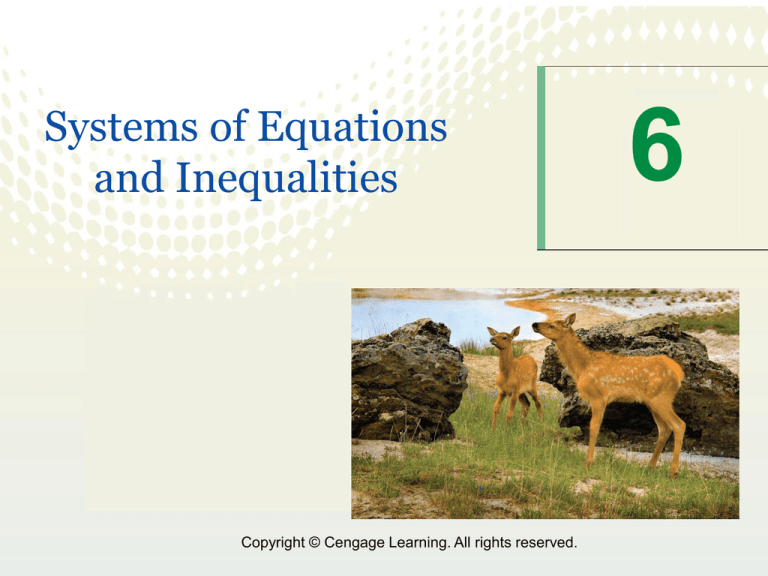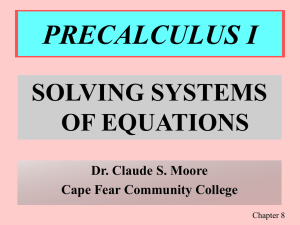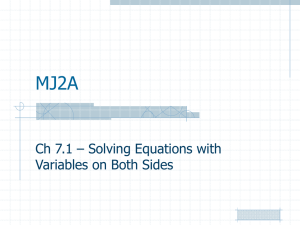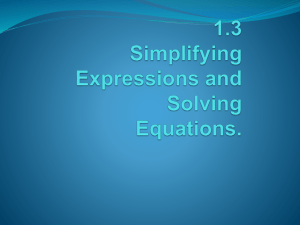
Systems of Equations
and Inequalities
Copyright © Cengage Learning. All rights reserved.
6
6.3
MULTIVARIABLE LINEAR SYSTEMS
Copyright © Cengage Learning. All rights reserved.
What You Should Learn
• Use back-substitution to solve linear systems in
row-echelon form.
• Use Gaussian elimination to solve systems of
linear equations.
• Solve nonsquare systems of linear equations.
• Use systems of linear equations in three or more
variables to model and solve real-life problems.
3
Row-Echelon Form and
Back-Substitution
4
Row-Echelon Form and Back-Substitution
The method of elimination can be applied to a system of
linear equations in more than two variables.
In fact, this method easily adapts to computer use for
solving linear systems with dozens of variables.
When elimination is used to solve a system of linear
equations, the goal is to rewrite the system in a form to
which back-substitution can be applied.
5
Row-Echelon Form and Back-Substitution
Consider the following two systems of linear equations.
System of Three Linear Equations in Three Variables:
x – 2y + 3z = 9
–x + 3y
= –4
2x – 5y + 5z = 17
Equivalent System in Row-Echelon Form:
x – 2y + 3z = 9
y + 3z = 5
z=2
6
Row-Echelon Form and Back-Substitution
The second system is said to be in row-echelon form,
which means that it has a “stair-step” pattern with leading
coefficients of 1.
After comparing the two systems, it should be clear that it is
easier to solve the system in row-echelon form, using
back-substitution.
7
Example 1 – Using Back-Substitution in Row-Echelon Form
Solve the system of linear equations.
x – 2y + 3z = 9
Equation 1
y + 3z = 5
Equation 2
z=2
Equation 3
Solution:
From Equation 3, you know the value of z. To solve for y,
substitute z = 2 into Equation 2 to obtain
y + 3(2) = 5
y = –1.
Substitute 2 for z.
Solve for y.
8
Example 1 – Solution
cont’d
Then substitute y = –1 and z = 2 into Equation 1 to obtain
x – 2(–1) + 3(2) = 9
x = 1.
Substitute –1 for y and 2 for z.
Solve for x.
The solution is x = 1, y = –1, and z = 2, which can be
written as the ordered triple (1, –1, 2).
9
Gaussian Elimination
10
Gaussian Elimination
Two systems of equations are equivalent if they have the
same solution set.
To solve a system that is not in row-echelon form, first
convert it to an equivalent system that is in row-echelon
form by using the following operations.
11
Gaussian Elimination
Rewriting a system of linear equations in row-echelon form
usually involves a chain of equivalent systems, each of
which is obtained by using one of the three basic row
operations.
This process is called Gaussian elimination, after the
German mathematician Carl Friedrich Gauss.
12
Example 3 – Using Gaussian Elimination to Solve a System
Solve the system of linear equations.
x – 2y + 3z = 9
–x + 3y
= –4
2x – 5y + 5z = 17
Equation 1
Equation 2
Equation 3
Solution:
Because the leading coefficient of the first equation is 1,
you can begin by saving the x at the upper left and
eliminating the other x-terms from the first column.
Write Equation 1.
Write Equation 2.
Add Equation 1 to Equation 2.
13
Example 3 – Solution
cont’d
x – 2y + 3z = 9
y + 3z = 5
2x – 5y + 5z = 17
Multiply Equation 1 by –2.
Write Equation 3.
Add revised Equation 1 to Equation 3.
14
Example 3 – Solution
cont’d
x – 2y + 3z = 9
y + 3z = 5
–y – z = –1
Now that all but the first x have been eliminated from the
first column, go to work on the second column. (You need
to eliminate y from the third equation.)
x – 2y + 3z = 9
y + 3z = 5
2z = 4
15
Example 3 – Solution
cont’d
Finally, you need a coefficient of 1 for z in the third
equation.
x – 2y + 3z = 9
y + 3z = 5
z=2
This is the same system that was solved in Example 1,
and, as in that example, you can conclude that the solution
is
x = 1, y = –1, and z = 2.
16
Gaussian Elimination
As with a system of linear equations in two variables, the
solution(s) of a system of linear equations in more than two
variables must fall into one of three categories.
We have learned that a system of two linear equations in
two variables can be represented graphically as a pair of
lines that are intersecting, coincident, or parallel.
17
Gaussian Elimination
A system of three linear equations in three variables has a
similar graphical representation—it can be represented as
three planes in space that intersect in one point (exactly
one solution) [see Figure 6.12], intersect in a line or a plane
(infinitely many solutions) [see Figures 6.13 and 6.14], or
have no points common to all three planes (no solution)
[see Figures 6.15 and 6.16].
Solution: one point
Solution: one line
Figure 6.12
Figure 6.13
Solution: one plane
Figure 6.14
Solution: none
Figure 6.15
Solution: none
Figure 6.16
18
Nonsquare Systems
19
Nonsquare Systems
So far, each system of linear equations you have looked at
has been square, which means that the number of
equations is equal to the number of variables.
In a nonsquare system, the number of equations differs
from the number of variables.
A system of linear equations cannot have a unique solution
unless there are at least as many equations as there are
variables in the system.
20
Example 6 – A System with Fewer Equations than Variables
Solve the system of linear equations.
x – 2y + z = 2
2x – y – z = 1
Equation 1
Equation 2
Solution:
Begin by rewriting the system in row-echelon form.
x – 2y + z = 2
3y – 3z = –3
x – 2y + z = 2
y – z = –1
21
Example 6 – Solution
cont’d
Solve for y in terms of z, to obtain
y = z – 1.
By back-substituting y = z – 1 into Equation 1, you can
solve for x, as follows.
x – 2y + z = 2
x – 2(z – 1) + z = 2
x – 2z + 2 + z = 2
x=z
Write Equation 1.
Substitute z – 1 for y in Equation 1.
Distributive Property
Solve for x.
22
Example 6 – Solution
cont’d
Finally, by letting z = a, where a is a real number, you have
the solution
x = a,
y = a – 1,
and
z = a.
So, every ordered triple of the form
(a, a – 1, a)
a is a real number.
is a solution of the system. Because there were originally
three variables and only two equations, the system cannot
have a unique solution.
23
Nonsquare Systems
In Example 6, try choosing some values of a to obtain
different solutions of the system, such as (1, 0, 1), (2, 1, 2),
and (3, 2, 3).
Then check each of the solutions in the original system to
verify that they are solutions of the original system.
24
Applications
25
Example 7 – Vertical Motion
The height at time t of an object that is moving in a
(vertical) line with constant acceleration a is given by the
position equation
The height s is measured in feet, the acceleration a is
measured in feet per second squared, t is measured in
seconds, v0 is the initial velocity (at t = 0), and s0 is the
initial height.
26
Example 7 – Vertical Motion
cont’d
Find the values of a, v0, and s0 if s = 52 at t = 1, s = 52 at
t = 2, and s = 20 at t = 3, and interpret the result.
(See Figure 6.17.)
Figure 6.17
27
Example 7 – Solution
By substituting the three values of t and s into the position
equation, you can obtain three linear equations in a, v0, and
s0.
When t = 1:
a(1)2 + v0(1) + s0 = 52
When t = 2:
a(2)2 + v0(2) + s0 = 52
2a + 2v0 + s0 = 52
When t = 3:
a(3)2 + v0(3) + s0 = 20
9a + 6v0 + 2s0 = 40
a + 2v0 + 2s0 = 104
This produces the following system of linear equations.
a + 2v0 + 2s0 = 104
2a + 2v0 + s0 = 52
9a + 6v0 + 2s0 = 40
28
Example 7 – Solution
cont’d
Now solve the system using Gaussian elimination.
a + 2v0 + 2s0 = 104
– 2v0 – 3s0 = –156
9a + 6v0 + 2s0 = 40
a + 2v0 + 2s0 = 104
– 2v0 – 3s0 = –156
– 12v0 – 16s0 = –896
a + 2v0 + 2s0 = 104
– 2v0 – 3s0 = –156
2s0 = 40
29
Example 7 – Solution
cont’d
a + 2v0 + 2s0 = 104
v0 + s0 = 78
s0 = 20
So, the solution of this system is a = –32, v0 = 48, and
s0 = 20, which can be written as (–32, 48, 20).
This solution results in a position equation of
s = –16t2 + 48t + 20 and implies that the object was thrown
upward at a velocity of 48 feet per second from a height of
20 feet.
30









